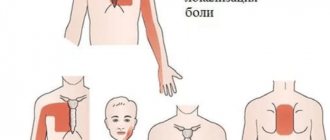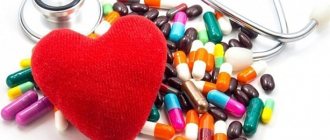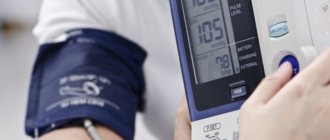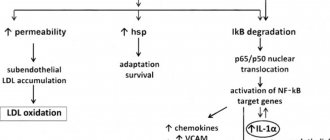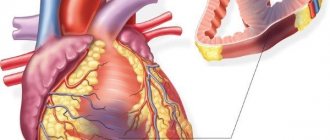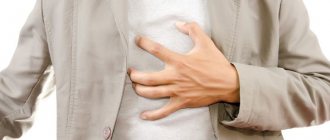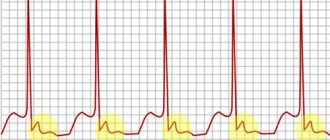Heart diseases often manifest themselves as subtle symptoms, more likely to indicate autonomic disorders than serious pathologies. In men, signs of organic heart damage and vascular atherosclerosis are absent for a long time or are expressed in conditions in which it is quite difficult to suspect any abnormalities. But according to statistics, it is the stronger sex that most often becomes the victim of heart attacks that end in death. In most cases, this could have been avoided if the man had been promptly diagnosed and treated. That is why every person needs to have an idea of what direct and indirect signs may indicate disorders of the cardiovascular system.
First symptoms
The reasons that pathologies of the cardiovascular system are more often formed in representatives of the male part of the population are due to the presence of the following provoking factors:
- abuse of tobacco and alcohol products;
- chronic stressful situations;
- production of sex hormones.
Signs of a malfunction of the heart can be disguised as other negative conditions, which also distinguishes the first symptoms of cardiovascular disease in men from those in the female half of the population. For example, you may experience:
- difficulties in the sexual sphere;
- unreasonable feelings of anxiety;
- frequent urge to cough;
- feeling of discomfort;
- pressure in the projection of the heart.
It is important to recognize such warning signs early. If the malaise recurs at intervals, it is necessary to consult with a specialist and undergo an appropriate examination: laboratory and instrumental. Paying attention to your own health is the key to longevity and high productivity.
What heart diseases are more common in men and why?
The most common cardiac pathologies among men are coronary heart disease (CHD) and arterial hypertension.
The first develops due to a disorder of adequate blood supply to the myocardium (heart muscle). The main causes are blood clots (thrombi) or atherosclerotic plaques (due to impaired fat metabolism). Hypertension is characterized by a persistent increase in blood pressure with signs of target organ damage without an organic cause (essential, primary) or against the background of pathology of other systems.
Reasons for the frequent development of heart disease symptoms in men:
drinking alcohol with great frequency and in high doses;- smoking;
- tendency to obesity. Recent data confirm that overweight is more common in men (over 30 years, the incidence of pathology has increased from 30% to 38% of the entire male population of the planet);
- low physical activity. Most office workers do not maintain adequate physical activity;
- negative impact of stress factors. It has been scientifically proven that men have less pronounced emotional, behavioral and social adaptation in times of crisis;
- lack of cardioprotective effect of estrogens. Female hormones serve as protection for blood vessels throughout the entire reproductive age.
The complex effect of these factors contributes to damage to the structure of the vascular wall and the properties of the blood. Blood clots form in the lumen of the arteries, autonomic (autonomous) regulation of tone is disrupted, and atherosclerotic plaques develop in the affected areas. Manifestations of cardiovascular pathology (in general) are more typical for men of working age with a high level of activity and responsibility.
In females, vegetative-vascular dystonia (functional disorder) is more often diagnosed. Takatsubo cardiomyopathy (broken heart syndrome), which occurs in old age after a strong emotional experience, is considered an exclusively female pathology.
Shortness of breath and fatigue
Many of us are accustomed to using personal vehicles and elevators to get around. Therefore, there is a minimal chance for physical activity. If, for a number of reasons, a person is forced to climb the stairs and suddenly discovers that he has shortness of breath already on the second or third floors, this is an alarming signal.
Quick fatigue while working around the house, playing with children, walking around the city - all these are also signs that physical inactivity has weakened the cardiovascular system. However, shortness of breath and increased fatigue may indicate established coronary insufficiency. After all, during physical activity, the myocardium needs more nutrients and oxygen. Their deficiency will provoke the appearance of negative symptoms, including pain impulses in the projection of the heart.
Among the preventive measures, cardiologists indicate:
- visiting the swimming pool, gyms, fitness clubs;
- a ride on the bicycle;
- daily long walks, for example, from work to home.
Classification by type of disease
Sometimes heart disease is inflammatory in nature. Some inflammations occur on a bacterial basis or develop as complications after a sore throat, flu and other diseases. In some cases, during inflammatory processes in other organs, toxins enter the bloodstream and then reach the heart.
Sometimes a person does not feel any symptoms. But in the acute form, the signs of the disease appear clearly:
- weakness, powerlessness;
- emotional instability, fatigue;
- low-grade body temperature;
- pain behind the sternum, from which traditional medicines do not help;
- changes in heart rhythm - arrhythmia, rapid or slow heartbeat;
- bluish skin color, swollen veins in the neck are clearly visible;
- shortness of breath, swelling of the limbs;
- sudden changes in blood pressure.
Men are more likely to suffer from heart disease, since women are protected by the hormone estrogen.
The most dangerous age for men is about 40 years old; it is at this time that most heart attacks occur and many diseases develop.
Therefore, men should closely monitor their health and seek medical help when the first signs of heart disease appear.
The disease is divided into types according to reversibility and severity. Chronic ones can last for several years, while acute ones can last for a couple of hours or even minutes.
- Sudden coronary death. This type of ischemia after its onset within a few hours leads to death. Refers to acute.
- Angina pectoris is the most “popular” type. Its peculiarity is that the pain is stabbing in nature and manifests itself in one place. Typically, the chest area is affected first, accompanied by difficulty breathing. The lesion then moves to the left arm or shoulder blade. Less often - in the stomach, which can complicate diagnosis. A subtype of angina is tense. It is the result of physical activity. It is also divided into: Stable, arising as a result of a specific load - running or climbing stairs.
- Unstable - the result of myocardial infarction.
Most pathological processes occurring in the myocardium lead to the appearance of similar clinical symptoms. A reliable determination of the cause of cardiac symptoms is carried out by a cardiologist using objective research methods, which include:
- ECG (electrocardiogram) is a functional study that makes it possible to determine the localization and nature of the pathological process, as well as disturbances in the rhythm and frequency of contractions.
- Holter monitoring is a modern functional study that is carried out using a portable electrocardiograph throughout the day. In this case, the patient lives a normal life, but with the help of research it is possible to detect periodic, unstable changes in the functional state of the heart.
- Ultrasound (echocardiography) is an instrumental diagnostic technique that visualizes all structural changes that result in the appearance of signs of pathology.
- A biochemical blood test to determine the activity of the enzymes creatine phosphokinase, alanine transferase, and aspartame transferase, which is carried out to detect the death of cardiac muscle cells (cardiomyocytes).
- Monitoring the level of systemic blood pressure, which allows not only to detect, but also to predict the development of cardiac pathology.
Typically, men associate cardiovascular diseases with increased blood pressure and chest pain (angina). The worst option is a heart attack. These diseases are the most common, but there are many others.
Men may experience pathologies such as heart rhythm disturbances, inflammatory heart diseases (pericarditis, myocarditis, endocarditis), cardiomyopathy, heart failure, etc.
Among smokers, a vascular disease called obliterating endarteritis is especially common. It can lead to gangrene of the feet.
The most severe complications of cardiovascular pathologies are heart attack and stroke. They are the ones that lead to death and make a person disabled.
Nausea and gastralgia
For some, discomfort associated with disruptions in the activity of the heart is manifested not by the well-known attack of pressing pain in the left half of the chest, but by nausea and discomfort in the epigastric region.
Many people mistake this condition for banal indigestion and try to eliminate it by taking activated charcoal or digestive enzymes. This is unacceptable: you must first undergo a diagnostic examination.
Pain in the stomach is due to the high position of the diaphragm. It is adjacent to the lower edge of the heart, which is why painful signals from it can be mistaken for damage to the stomach.
Conducting a screening study, for example, using an ECG helps put everything in its place. Deviations in one or another lead on the cardiogram will indicate to the specialist exactly where the failure occurred. Therapeutic measures will help restore the functioning of the heart and will serve as a prevention of such a formidable pathology as myocardial infarction.
Swelling in the legs
If a man notices that by the evening he has marks from the elastic of his socks on his ankles, this happens almost every day - this indicates that his “engine” may be malfunctioning. The heart pumps blood every minute, and if it ceases to fully cope with this function, blood accumulates in the lower extremities. At the same time, its liquid part seeps from the vessels into the tissues, and swelling appears.
Initially, symptoms occur several times during the week, usually in the evening. But as the pathology progresses, swelling does not disappear during the period of night rest, and swelling is observed throughout the entire working day.
A characteristic feature of the swelling, caused precisely by a disorder of cardiac activity, is symmetry: it occurs simultaneously on both limbs. You can detect it by pressing on the ankle, a kind of “hole” will appear. Timely treatment measures help restore the elasticity of vascular structures, improve the pumping function of the heart, and prevent the formation of heart failure.
Main symptoms of heart disease in men
Most people think that if there is pain in the heart area, it means it is sick.
But, unfortunately, the patient does not always feel unwell or discomfort if there is any disease of the cardiovascular system. In most cases, symptoms of heart disease in men do not appear for quite a long period of time. In this regard, a person learns about the diagnosis too late, when the disease is already in a severe stage of development.
Most people think that if there is pain in the heart area, it means it is sick. But, unfortunately, the patient does not always feel unwell or discomfort if there is any disease of the cardiovascular system.
First symptoms
Men suffer from heart disease more often than women. There are many reasons for this: smoking, alcohol, poor lifestyle. The signs of these diseases in men are often different from similar signs in women. Men sometimes notice problems with erection, unreasonable feelings of anxiety, coughing, and a feeling of pressure in the chest. It is very important to notice these signs in time and begin treatment.
- Cough. Most often this is a signal of a cold or respiratory illness, but sometimes it indicates heart disease. This is not difficult to determine. For heart pathologies, the use of expectorants is useless; they do not help. A cough should be especially alarming when a person is lying down.
- Another symptom is shortness of breath. It manifests itself as a feeling of lack of air or slight suffocation when a person is physically active or at rest. This sign is worth paying special attention to, since heart disease is present in 90% of people suffering from shortness of breath.
- Weakness and fatigue. They can be a consequence of increased physical activity, stress and other factors. However, this may be one of the signs of heart disease. Usually, with heart pathologies, these symptoms intensify over time, appetite disappears, and swelling of the legs appears.
- High pressure. If it is constantly elevated, this should be a cause for alarm. Arrhythmia, a rare or, conversely, too fast pulse may be a sign of developing coronary artery disease.
- Swelling. Sometimes it appears after eating salty foods, large amounts of liquid, or alcohol. But it may be a consequence of cardiac dysfunction. Most often the face, arms and legs swell.
- Pain in the neck, left arm, back or shoulder may indicate osteochondrosis and myositis. But it can also be an early sign of heart disease.
- Chest pain. Pressure, pain, compression in the chest area are a signal of the development of cardiac pathology. The pain can radiate to the neck, back, shoulder, occurs unexpectedly or appears regularly.
- Fainting. It can occur due to severe chest pain or due to developing heart failure. Unexpected fainting is very serious, as acute heart failure can lead to death.
The main heart diseases in men are ischemia, arrhythmias, heart failure, and inflammatory diseases.
- The main symptom is pain. Burning, cutting, shooting, it can appear during physical activity and disappear after it.
- Not only the chest area can hurt, but also the arm, back, and neck.
- Shortness of breath that gets worse over time.
- Sweating.
- Weakness, feeling tired, dizzy.
- Interruptions in the work of the heart, when it seems to freeze.
- Nausea and vomiting.
Heart diseases
Each heart disease in men is characterized by special symptoms and course. Here's a more detailed description:
Each heart disease in men is characterized by special symptoms and course. Here's a more detailed description:
Are there any special symptoms of heart pathology that are typical for men?
The symptoms of cardiovascular diseases do not have sufficient specificity and often mimic other pathologies. Acute conditions that are accompanied by a threat to the patient’s life require correct diagnosis and timely initiation of treatment. The conducted studies highlighted the main differences in the course of cardiac pathology in men and women (using the example of coronary artery disease).
A characteristic attack of anginal pain behind the sternum.
Often there is a blurred picture with low pain intensity or a “painless” version of angina.
From a psychological point of view, men are more responsible and attentive to their health, so they are more likely to notice changes.
The most typical symptoms of heart disease in men:
- increased heart rate;
- a feeling of interruptions or temporary stops in the heart;
- the appearance of signs at low pressure values (upper 150-160 mm.st.st.). For comparison, women complain of headaches and weakness when readings are above 180;
- shortness of breath (high frequency of shallow breathing), which is formed due to the inability of the heart to transport a sufficient amount of oxygen to the tissues;
- fatigue when doing normal household chores;
- pain behind the sternum of high intensity, which requires stopping the usual activities.
Autonomic changes during an attack are more typical in females due to the lability of the nervous system.
- increased heart rate;
- a feeling of interruptions or temporary stops in the heart;
- the appearance of signs at low pressure values (upper 150-160 mm.st.st.). For comparison, women complain of headaches and weakness when readings are above 180;
- shortness of breath (high frequency of shallow breathing), which is formed due to the inability of the heart to transport a sufficient amount of oxygen to the tissues;
- fatigue when doing normal household chores;
- pain behind the sternum of high intensity, which requires stopping the usual activities.
What symptoms appear?
Heart disease has clinical manifestations that mainly include the following:
- Painful sensations of varying nature and intensity with a predominant localization in the chest area. The first sign of the disease is the appearance of discomfort in the chest, as well as heartburn.
- Shortness of breath with a feeling of lack of air.
- Feelings of anxiety appear.
- Feeling of discomfort in the chest area in the form of palpitations.
- Sleep disorders such as insomnia.
Somewhat less frequently, with an atypical course of the pathological process, a man may be bothered by discomfort in the stomach, nausea, and periodic vomiting. Based on the clinical symptoms, one can suspect the nature and origin of the disease, but the diagnosis can only be made by a cardiologist. To do this, he often prescribes additional examination.
Somewhat less frequently, with an atypical course of the pathological process, a man may be bothered by discomfort in the stomach, nausea, and periodic vomiting. Based on the clinical symptoms, one can suspect the nature and origin of the disease, but the diagnosis can only be made by a cardiologist. To do this, he often prescribes additional examination.
Symptoms of heart disease
It so happens that women take much more care of their health and visit the doctor more often if something bothers them. A man who suddenly begins to suffer from a suffocating cough will write it off as a cold for the rest of his life. In fact, a dry cough, especially accompanied by chest pain, is the first sign of heart disease. Other most common symptoms of heart disease in men include:
- shortness of breath and constant fatigue;
- nausea, heartburn;
- headache;
- swelling in the legs;
- increased sweating;
- insomnia;
- gastralgia;
- pale skin;
- slight trembling of the limbs;
- incomplete erection or its absence;
- frequent urge to go to the toilet;
- hypertension;
- dizziness;
- confusion;
- neurosis.
More understandable manifestations of heart disease are various types of arrhythmias, in which the following conditions can be observed:
- sudden increase in heart rate;
- scratching or stabbing pain in the chest area;
- intense heartbeat, sensation of pulsation of the neck veins;
- heart stopping, noticeable pauses between contractions;
- feeling of a lump in the stomach or throat;
- extraordinary heart beats, failure of normal rhythm without acceleration of heart rate;
- arterial hypertension;
- a feeling of lack of air against the background of an accelerated heart rate, even at rest.
If a man has one or several of the above symptoms, it is necessary to visit a cardiologist in the near future and undergo appropriate diagnostics. Even hidden diseases, the manifestations of which do not cause serious discomfort, can shorten life by 10-15 years, so it is important to be attentive to your health and receive timely treatment.
If a man has one or several of the above symptoms, it is necessary to visit a cardiologist in the near future and undergo appropriate diagnostics. Even hidden diseases, the manifestations of which do not cause serious discomfort, can shorten life by 10-15 years, so it is important to be attentive to your health and receive timely treatment.
Headache
It does not accompany all forms of heart failure. Refers to neurological symptoms.
The reason is a decrease in the quality of trophism (nutrition) of cerebral tissues. Localized in the parietal, temporal regions, and the back of the head. It can be diffuse, distributed throughout the skull (diffuse character).
It is considered an alarming symptom, because it indicates increasing phenomena of cerebral ischemia.
Sooner or later, without treatment and proper control, acute cerebrovascular insufficiency will occur - a stroke with unpredictable consequences.
If detected, parallel therapy is required with the use of drugs that improve the trophism of nerve fibers, nootropics that stabilize the speed and quality of metabolic processes.
But this is a symptomatic measure. The main efforts should be directed towards eliminating heart failure.
An increase in heart rate due to the activation of a special cluster of cells (the so-called sinus node or sinus node).
Women are more likely than men to ignore symptoms of heart disease
Today, heart disease is the leading cause of death in women. However, there is an opinion in society that mainly men suffer from heart disease. Apparently, partly under the influence of this myth, women pay less attention to alarming symptoms than men and more often postpone their visit to the doctor.
American cardiologists came to this opinion.
Delay is deadly. Although businessmen say that “time is money,” we... Doctors, we say: “Time is the heart muscle.” When a person has a heart attack, heart muscle cells begin to die within 30 minutes. It is extremely important to get to the hospital immediately, where a doctor can clear the blocked artery and restore blood flow to the heart muscle.
Swelling
Severe swelling, especially towards the end of the day, can occur due to an abundance of salty foods, kidney problems, and also due to heart failure. This happens because the heart cannot cope with pumping blood, it accumulates in the lower extremities, causing swelling.
Vascular complications are very easily confused with gastritis or exacerbation of an ulcer, the symptoms of which are nausea and vomiting. The fact is that the lower part of the heart is located close to the stomach, so the symptoms can be misleading and even resemble food poisoning.
Risk factors for cardiovascular disease
Many men are at high risk of developing heart disease. In 2013, the AHA reported that only a quarter of men met physical activity recommendations. Approximately 73 percent of men age 20 and older are overweight or obese. And about 20 percent of men smoke, which can cause blood vessels to narrow. Narrow blood vessels are a precursor to some types of heart disease.
Other risk factors include:
- diet high in saturated fat
- excessive alcohol consumption
- high cholesterol
- diabetes
- hypertension (high blood pressure)
According to the Centers for Disease Control and Prevention (CDC), nearly half of all Americans—men and women—have three or more risk factors for cardiovascular disease. The state of affairs in Europe is approximately the same.
These symptoms may be signs that your blood vessels are narrowed somewhere. This narrowing, which can be caused by the buildup of cholesterol plaques, makes it difficult for oxygenated blood to circulate throughout the body.
Painful sensations
The first “bells” of heart disease can also be confused with osteochondrosis. Men most often complain of pain in all parts of the body, and this is true.
- in the area of the shoulder blades;
- in the neck area;
- in the arms and shoulders.
It is this symptom that clearly manifests itself in the early stages. During intense physical exertion or after emotional upheaval, pain occurs due to angina pectoris.
In advanced cases, pain can occur when a person is at rest - this can be a pronounced symptom of an imminent myocardial infarction. Heart medications help stop an attack, but they will not help prevent a heart attack. In this case, hospital treatment is required.
It is chest pain that frightens patients with heart disease. The nature of the pain can be different, often severe and sharp pain occurs, which is subsequently replaced by a burning sensation behind the sternum. Burning and sharp sensations in the chest at any time of the day can occur due to spasm of the coronary vessels.
A similar symptom is characteristic of angina, which often acts as a precursor to ischemia and heart attack. With a progressive heart attack, pain may radiate to the left arm.
Painful sensations can be very severe, sometimes they cause fainting.
It should be remembered that it is simply impossible to make a diagnosis based on such symptoms. Only an experienced cardiologist, after reviewing the examination results, will be able to identify the disease and choose the necessary technique to get rid of it.
Painful sensations can be very severe, sometimes they cause fainting.
Headache
Occasionally, every person experiences pain impulses in one or another area of the head. What should be alarming is persistent pain in the occipital or temporal parts of the skull that does not respond to conventional analgesics and occurs in the morning.
Such a signal indicates the debut of such a terrible pathology with its complications as hypertension. In the absence of adequate treatment procedures, high pressure parameters lead to the formation of ischemic failure in the heart muscle, and then to myocardial infarction.
The optimal pressure parameters for people of working age are recognized as 120/75 mmHg. Art. Of course, each person is unique, and individuals have higher or lower blood pressure numbers. However, everything that exceeds 140/80 mmHg. Art., requires observation by a cardiologist and additional diagnostic examination.
Arthralgia
Another unrelated, in the opinion of most people, symptom of a malfunction of the heart is pain in the elbow or wrist, sometimes spreading to the entire arm. It is alarming if such a sign appears when a person exceeds his usual load, for example, when climbing quickly up the stairs. Of course, if there was some kind of injury before this, arthralgia may well arise against this background. However, recurrence of the unpleasant sensation on the left side and after physical activity requires consultation with a specialist and hardware examination of ECG, ECHO CG, CM.
It is necessary to be especially vigilant if factors that provoke a heart attack are present:
- smoking;
- severe stressful situations;
- obesity;
- tendency to physical inactivity;
- harmful working conditions;
- unfavorable heredity
Urge to go to the toilet at night
If you often and unbearably want to go to the toilet at night to empty your bladder, you should think about a malfunction of the heart. Excess fluid in the body forces the heart muscle to work harder, and at night the blood flow to the heart increases, because in a lying position everything that was in distant parts of the body flows upward.
The processed fluid enters the bladder, and the person is forced to wake up to visit the toilet. If a man has no history of infectious diseases of the genitourinary system: pyelonephritis, cystitis, prostatitis, he should be wary and visit a specialist for a heart examination.
conclusions
Conditions when the heart “plays pranks” can be caused by various pathological processes and reactions. The male body is characterized by a greater tendency to develop cardiovascular pathology. However, ease of diagnosis (typical clinical picture), high sensitivity to therapy in combination with lifestyle modification form a more favorable prognosis than for women.
The following sources of information were used to prepare the material.
For many decades, medical workers have pointed out that heart disease is in first place among the causes of high mortality in the male population. Persistent educational work is being carried out. After all, knowing the symptoms of heart disease in men, you can prevent serious consequences and complications.
Most, unfortunately, learn about the disease at a late stage of its formation, when it is no longer possible to cure. In fact, all you need to do is pay attention to the warning signs in time and seek advice from a specialist.
Chest pain
Painful sensations arise at the initial stage of disruptions in the activity of the heart only at the initial stage: short-term, stabbing, pressing, not radiating either to the shoulder blade or to the arm. They go away on their own, and the man explains them with other reasons, for example, overwork or a stressful situation.
However, such conditions are repeated more and more often, and it is they that make a person think about whether heart problems have arisen in his body.
When the heart muscle does not receive the required amount of nutrients, it reacts with pain impulses.
Patients describe the situation in different ways: some have “a stone on their chest,” while others have a stinging, squeezing, pressing sensation. All these clinical manifestations directly indicate cardiovascular pathology and require a comprehensive diagnostic examination.
What are the first symptoms? When is it time to go to the doctor?
Many men are sure that if there are disturbances in their heart and blood vessels, they will immediately feel it. But in fact, the first symptoms are usually overlooked and perceived as something insignificant. So - “it stung and went away, no big deal.”
It is a big mistake to think that heart disease mainly manifests itself as severe chest pain. Most often, the first symptoms are minor. This may include periodic shortness of breath during moderate physical activity, headaches, tinnitus, chest discomfort, a feeling as if something is squeezing inside, numbness in the fingers and toes, and slight swelling in the evenings. And the pain is not always localized in the chest. They can occur in the neck, jaw, or under the shoulder blade.
Even the smallest symptoms should not be ignored. Be sure to visit a doctor. Timely treatment will help avoid serious complications in the future.
Erection problems can also indicate cardiovascular disease. Difficulties in bed arise due to the fact that the arteries supplying the penis become clogged and blood flow is disrupted. The same thing happens in other vessels of the body.
Signs of heart problems
Men are more likely than women to suffer from heart pathologies, this is convincingly demonstrated by medical research. Especially in middle age. At first, a slight ailment is either not noticed by a man at all, or is ignored due to busyness and inattention to his health.
Many cardiac pathologies are accompanied by arrhythmias. The following symptoms indicate this condition:
- the feeling of a sinking heart, missing the next beat, a frightening second pause followed by a “gallop”, accompanied by a fear of death, severe weakness, dizziness;
- attacks of rapid heartbeat occur suddenly, have varying intensity and duration, the root cause may be various intoxications, stressful situations, overwork, endocrine pathologies;
- pre-fainting states: the man suddenly turns pale, he experiences heavy sweating and confusion.
It is imperative to undergo a comprehensive examination and not delay visiting a specialist. Even if a person has only once encountered the symptoms described above, this is a reason to be wary; cardiovascular disorders can be hidden for a long time and make themselves felt already at the stage of formed complications.

